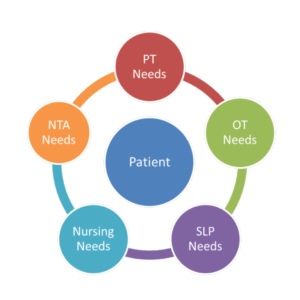Making the Most of RUG-53
|
| BY RENA R. SHEPHARD, MHA, RN, FACDONA, RAC-C |
| The new classification system can still maximize your deserved Medicare reimbursement-but remember, hierarchy isn’t everything The New Year brought with it significant changes in Medicare Part A reimbursement and, although the changes are not very complicated on the surface, it’s probably going to take some time for nursing home providers to get the hang of them. The refinements to the Resource Utilization Groups (RUGs) that form the foundation of the Skilled Nursing Facility Prospective Payment System (SNF PPS) added nine new RUGs to the top of the hierarchy of RUG categories, resulting in a 53-group system. These new groups were designed to compensate for a defect in the system that had failed to account for the cost of extensive nursing services when a resident received both skilled-level rehabilitation services and extensive nursing services. Creation of these nine new groups did not require CMS to perform complicated new calculations-it combined the existing Rehabilitation RUGs with the existing Extensive Services RUGs for residents who classify into at least one of each. For all other Part A residents, the RUG calculations are unchanged from the 44-group version. Although the calculations that classify a resident into a RUG may not be particularly complicated, determining which RUG category will be paid for a particular resident is not as straightforward as it may have seemed to be in the past. The reason is related to the two different classification systems that are used to organize the RUGs: “hierarchical” and “index maximizing.” While providers have been aware of the existence of these two systems in the past, a better understanding of the differences between them is essential to being able to work with the RUG-53 system. The hierarchical system is a convenient way to organize the RUG categories to describe their relationship to each other. In the RUG-44 system, the Rehabilitation groups were at the top of the hierarchy, organized in descending order based on the number of rehabilitation minutes, days, and disciplines involved. The skilled-level categories below Rehabilitation were, in descending order, Extensive Services, Special Care, and Clinically Complex. Each RUG category was further subdivided into levels within each RUG. For example, Rehabilitation Ultra High was subdivided into levels A, B, and C, depending on the resident’s ADL status. In the RUG-53 system, this hierarchy remains intact. The only change is that the new nine-group category Rehabilitation + Extensive Services now sits atop the RUG-44 hierarchy. However, a key point about the hierarchical classification is that even though in general it represents a descending level of patient acuity and resource utilization, just because a particular RUG is higher in the hierarchy does not necessarily mean that its acuity and resource utilization are higher, or that it pays more than all groups below it. The index maximizing classification system comes into play to determine the order by payment level. Based on time studies conducted by CMS, index maximizing employs the case-mix index (CMI), a number that represents the relative intensity of care for a RUG. A dollar amount is associated with the CMI to calculate the payment rate. The higher the CMI, the greater the intensity of care and the higher the payment will be. Typically, a RUG grouper determines all of the RUG classifications the resident qualifies for and pays the one with the highest rate, based on the CMI. With the RUG-44 system, the two classification systems generally placed the RUG levels in the same order. As a result, in practice, many providers expected a higher payment rate from any RUG higher on the hierarchy. The occasional variation tended to cause concern. For example, according to the 2005 federal Urban rate sheet (see “RUG Listing by CMI,” this page), Extensive Services 3 (SE3) paid more than Rehabilitation Medium A (RMA) and Rehabilitation Medium B (RMB), even though the therapy RUGs were higher on the hierarchy. Providers tended to attribute these variations to malfunctioning software, the effect of add-on payments, or unexplained anomalies. The real reason was that the rate, based on the CMI, was actually higher for SE3. With the combining of therapy RUGs with nursing RUGs that have high CMIs, these variations occur more often. The reason is as follows: the RUG system uses separate CMIs for therapy services and nursing services because the dollar amount associated with a unit of therapy CMI is lower than the amount associated with a unit of nursing CMI. Thus, a therapy RUG level with a high nursing CMI can pay more than a therapy RUG with a lower nursing CMI, even if the RUG has more therapy minutes. For example, the Rehabilitation High + Extensive Services High (RHX) category pays less than the Rehabilitation Medium + Extensive Services Low (RML) category (by federal Urban rates). To note why, see the following table: Even though RHX is higher in the hierarchy than RML, the high nursing component for RML compared with RHX pushes the CMI up to the point that the total rate is higher for RML than it is for RHX. Therefore, if a resident classifies into both RHX and RML, the payment will be for the category with the highest rate based on the CMI; i.e., RML. As a result of this increase in variations from the hierarchy when it comes to determining which RUG will be paid, providers should look to the chart that lists the RUG groups in order by total rate based on CMI rather than relying on the hierarchical order. It is important that clinical staff have easy access to the CMI list so that they can make good decisions about setting the Assessment Reference Date (ARD) on the MDS. Since the ARD establishes the observation period for each MDS item, it determines the care and services captured on the MDS. If a resident classifies into two different RUGs depending on where the ARD is set, interdisciplinary team members need to be able to select the one that best represents the intensity of care expected to be provided to the resident, thus providing the reimbursement the facility is entitled to. Rena R. Shephard, MHA, RN, FACDONA, RAC-C, is President of RRS Healthcare Consulting Services, San Diego. She is past president of the American Association of Nurse Assessment Coordinators (AANAC). For further information, phone (858) 592-6799 or e-mail RRS2000@aol.com. To send your comments to the author and editors, e-mail shephard0206@nursinghomesmagazine.com. |
Related Articles
Topics: Articles , Finance , MDS/RAI , Regulatory Compliance , Rehabilitation











